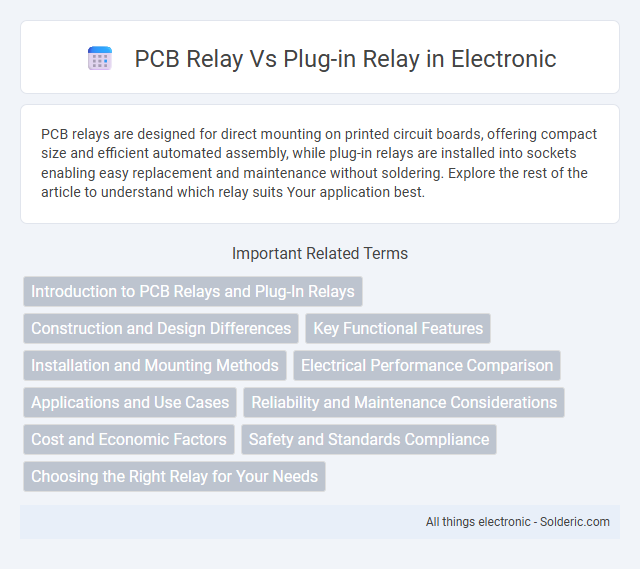PCB relays are designed for direct mounting on printed circuit boards, offering compact size and efficient automated assembly, while plug-in relays are installed into sockets enabling easy replacement and maintenance without soldering. Explore the rest of the article to understand which relay suits Your application best.
Comparison Table
| Feature | PCB Relay | Plug-in Relay |
|---|---|---|
| Mounting | Directly soldered onto PCB | Plugs into a socket or base on PCB |
| Replacement | Requires desoldering and resoldering | Easy to replace without soldering |
| Size | Usually compact, low profile | Typically bulkier due to socket |
| Cost | Generally lower cost | Higher cost due to socket interface |
| Reliability | Less prone to contact wear from removal | Socket contacts can wear over time |
| Application | Best for permanent PCB installations | Ideal for testing and frequent swapouts |
| Installation Time | Longer due to soldering process | Quick plug-and-play installation |
Introduction to PCB Relays and Plug-In Relays
PCB relays are designed for direct mounting onto printed circuit boards, offering compact size, fast switching speeds, and easy integration into automated electronic assemblies. Plug-in relays feature a modular design with sockets for quick replacement and maintenance, providing flexibility and durability in control panel applications. Both types serve crucial roles in electrical isolation and signal switching, optimized for specific installation environments and operational demands.
Construction and Design Differences
PCB relays feature a compact design with solder pins directly mounted on the printed circuit board, ensuring seamless electrical connections and reduced assembly time. Plug-in relays are built with socket-compatible terminals, allowing easy replacement and maintenance without desoldering, which suits applications requiring frequent relay swaps. Your choice depends on whether you prioritize space-saving integration or convenient serviceability in your electronic design.
Key Functional Features
PCB relays are designed for compact circuit board mounting with low power consumption and high switching speed, making them ideal for automated applications requiring precise control. Plug-in relays offer easy replacement and enhanced durability with features like screw-terminal connections and robust housings suitable for industrial environments. Your choice hinges on factors such as installation convenience, space constraints, and the operational reliability required for your specific application.
Installation and Mounting Methods
PCB relays are mounted directly onto printed circuit boards through hole or surface-mount technology, enabling compact and automated installation ideal for densely packed electronic circuits. Plug-in relays use socket bases that allow easy replacement and maintenance without soldering, providing flexibility in applications requiring frequent relay changes or testing. Both methods optimize space and reliability, but PCB relays streamline assembly for mass production, while plug-in relays enhance serviceability in complex control panels.
Electrical Performance Comparison
PCB relays typically offer faster switching speeds and lower contact resistance compared to plug-in relays, making them ideal for high-frequency applications and precise control circuits. Plug-in relays, while generally robust with higher current handling capabilities, exhibit longer mechanical response times and greater contact wear due to their construction. Electrical insulation and dielectric strength in PCB relays are optimized for compact, low-voltage environments, whereas plug-in relays provide superior isolation suitable for industrial and heavy-duty electrical loads.
Applications and Use Cases
PCB relays are ideal for compact electronic circuits requiring space-saving integration and are commonly used in telecommunications, automotive electronics, and industrial control systems. Plug-in relays offer easy replacement and are favored in applications like HVAC systems, building automation, and power distribution where maintenance efficiency is critical. Your choice between these relays should consider the application's need for compact design versus serviceability.
Reliability and Maintenance Considerations
PCB relays offer enhanced reliability due to their compact design and fewer mechanical connections, reducing the risk of contact wear and failure in your electronic circuits. Plug-in relays provide easier maintenance and replacement, as their socketed design allows quick swapping without soldering, minimizing downtime during repairs. Choosing between them depends on balancing the long-term durability of PCB relays with the convenient serviceability of plug-in relays in your applications.
Cost and Economic Factors
PCB relays generally offer lower costs due to their compact design and ease of automated assembly, making them ideal for high-volume production where budget efficiency is crucial. Plug-in relays, while typically more expensive upfront, provide economic advantages through easier maintenance and replacement, reducing downtime and labor costs in long-term operations. Your choice depends on balancing initial investment against operational flexibility and lifecycle expenses.
Safety and Standards Compliance
PCB relays are designed to meet strict industry safety standards such as UL, IEC, and RoHS, ensuring reliable insulation and reducing the risk of electrical hazards on compact circuit boards. Plug-in relays often incorporate conforming safety certifications for easier replacement and maintenance in industrial applications, enabling secure socket connections that minimize contact wear and overheating risks. Both relay types must adhere to voltage and current ratings specified by standards to guarantee operational safety and prevent electrical failures.
Choosing the Right Relay for Your Needs
Selecting the right relay depends on your application's space, mounting, and electrical requirements. PCB relays are compact, designed for direct soldering onto printed circuit boards, providing efficient signal isolation and minimal wiring. Plug-in relays offer easy replacement and higher power handling, ideal for applications requiring frequent maintenance or robust load switching.
PCB relay vs plug-in relay Infographic

 solderic.com
solderic.com